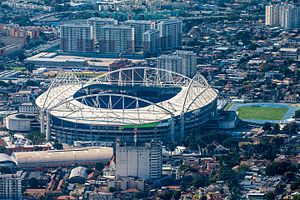Estádio Nilton Santos
| Engenhão | |

Aerial view of the stadium, 2016
|
|
| Location | Rio de Janeiro, Brazil |
|---|---|
| Public transit | Olímpica de Engenho de Dentro Station, SuperVia |
| Owner | Prefeitura do Rio de Janeiro |
| Operator | Botafogo |
| Capacity | 46,931, 60,000 (olympics) |
| Field size | 105 m × 68 m (344 ft × 223 ft) |
| Surface | Grass |
| Construction | |
| Built | 2003–07 |
| Opened | 2007, 2016 |
| Construction cost |
R$380 million (US$192 million) |
| Architect | Carlos Porto |
| Tenants | |
| Botafogo (2007–present) | |
The Estádio Olímpico Nilton Santos, formerly the Estádio Olímpico João Havelange (Portuguese pronunciation: [iʃˈtadʒw oˈɫĩpiku ˈʒwɐ̃w̃ ɐveˈlɐ̃ʒi]; English: João Havelange Olympic Stadium), is a multi-purpose stadium located in the neighbourhood of Engenho de Dentro in Rio de Janeiro, Brazil. It is used mostly for football matches and athletics and is the home stadium of the football club Botafogo. The stadium was built by a consortium under the leadership of Odebrecht S.A., from 2003 through to 2007, opening in time for the 2007 Pan American Games. It hosted the athletics competitions at the 2016 Summer Olympics and the 2016 Summer Paralympics.
The stadium is known by a number of names. The nickname Engenhão ([ẽʒẽˈɲɐ̃w̃]) refers to the location of the stadium. The stadium was named after former FIFA president and International Olympic Committee (IOC) member João Havelange. Havelange died during the 2016 Olympics at age 100. Between 2015 and 2017 the Rio municipality allowed Botafogo to refer to the stadium as Estádio Nilton Santos (English: Nilton Santos Stadium). The name honors Nilton Santos, regarded as one of the greatest defenders in the history of the game and a member of the World Team of the 20th Century. Botafogo initial efforts to have the name change made official but this was not immediately successful. In February 2017, the city of Rio de Janeiro officially renamed the stadium Estádio Olímpico Nilton Santos. Structural problems in the roof were identified in March 2013 that caused the stadium to be closed for repair. The stadium's capacity is intended to be increased to 60,000 for the Games.
...
Wikipedia
